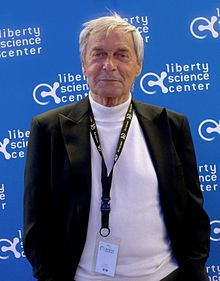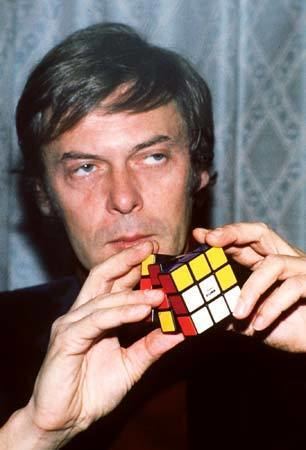Full Name Ernő Rubik Title Chairman Spouse Ágnes Hégely Children Zoltán Ernő Rubik | Employer Rubik Brand ltd. (UK) Nationality Hungarian | |
 | ||
Education 1962–67 University of Technology, Budapest (architecture)1967–71 Hungarian Academy of Applied Arts; Interior Architecture and Design Occupation Inventor, designer, board executive Board member of Judit Polgar Foundation Parents Magdolna Szántó, Ernő Rubik Similar Feliks Zemdegs, Jessica Fridrich, Mats Valk, Lucas Etter, László Bíró Profiles | ||
Great inventors episode 1 ern rubik
Ernő Rubik ([ˈrubik ˈɛrnøː]; born 13 July 1944) is a Hungarian inventor, architect and professor of architecture. He is best known for the invention of mechanical puzzles including Rubik's Cube (1974), Rubik's Magic, Rubik's Magic: Master Edition, and Rubik's Snake.
Contents
- Great inventors episode 1 ern rubik
- Ern rubik inventor kossuth award winning architect
- Childhood and parental influence
- Education
- Early professorship and birth of Rubiks Cube
- From classroom tool to Magic Cube to Rubiks Cube
- Other inventions
- Later career and other works
- Recent work and engagements
- Influences
- Cultural and leisure pursuits
- Prizes and awards
- Publications
- Foundations and appearances
- References
While Rubik became famous for inventing the Rubik's Cube and his other puzzles, much of his recent work involves the promotion of science in education. Rubik is involved with several organizations such as Beyond Rubik's Cube, the Rubik Learning Initiative and the Judit Polgar Foundation all of whose aim is to engage students in science, mathematics, and problem solving at a young age.

Ern rubik inventor kossuth award winning architect
Childhood and parental influence
Ernő Rubik was born in Budapest, Hungary, 13 July 1944, during World War II, and has lived all his life in Hungary. His father, Ernő Rubik Sr., was a flight engineer at the Esztergom aircraft factory, and his mother, Magdolna Szántó, was a poet.

His father, Ernő Sr., was a highly respected engineer of gliders. His extensive work and expertise in this area gained him an international reputation as an expert in his field. Ernő Rubik has stated that:
Education
From 1958 to 1962, Rubik specialised in sculpture at the Secondary School of Fine and Applied Arts. From 1962 to 1967, Rubik attended the Budapest University of Technology where he became a member of the Architecture Faculty. From 1967 to 1971, Rubik attended the Hungarian Academy of Applied Arts and was on the Faculty of Interior Architecture and Design.
Rubik considers university and the education it afforded him as the decisive event which shaped his life. Rubik has stated that, "Schools offered me the opportunity to acquire knowledge of subjects or rather crafts that need a lot of practice, persistence and diligence with the direction of a mentor."
Early professorship and birth of Rubik's Cube
From 1971 to 1979, Rubik was a professor of architecture at the Budapest College of Applied Arts (Iparművészeti Főiskola). It was during his time there that he built designs for a three-dimensional puzzle and completed the first prototype of the Rubik's Cube in 1974, applying for a patent on the puzzle in 1975. In an interview with CNN, Rubik stated that he was "searching to find a good task for my students."
From classroom tool to Magic Cube to Rubik's Cube
Starting with blocks of wood and rubber bands, Rubik set out to create a structure which would allow the individual pieces to move without the whole structure falling apart. Rubik originally used wood for the block because of the convenience of a workshop at the university and because he viewed wood as a simple material to work with that did not require sophisticated machinery. Rubik made the original prototypes of his cube by hand, cutting the wood, boring the holes and using elastic bands to hold the contraption together
Rubik showed his prototype to his class and his students liked it very much. Rubik realized that, because of the cube's simple structure, it could be manufactured relatively easily and might have appeal to a larger audience. Rubik's father possessed several patents, so Rubik was familiar with the process and applied for a patent for his invention. Rubik then set out to find a manufacturer in Hungary, but had great difficulty due to the rigid planned economy of Hungary at the time. Eventually, Rubik was able to find a small company that worked with plastic and made chess pieces. The cube was originally known in Hungary as the 'Magic Cube'.
Rubik licensed the Magic Cube to Ideal Toys, a US company in 1979. Ideal rebranded The Magic Cube to the Rubik's Cube before its introduction to an international audience in 1980. The process from early prototype to significant mass production of the Cube had taken over six years. The Rubik's Cube would go on to become an instant success worldwide, winning several Toy of the Year awards, and becoming a staple of 1980's popular culture. To date, over 350 million Rubik's Cubes have been sold, making it the best selling toy of all time.
Other inventions
In addition to Rubik's Cube, Rubik is also the inventor of Rubik's Magic, Rubik's Magic: Master Edition, Rubik's Snake, Rubik's Tangle, and Rubik's 360.
Later career and other works
In the early 1980s, he became the editor of a game and puzzle journal called ..És játék (...And games), then became self-employed in 1983, founding the Rubik Stúdió, where he designed furniture and games. In 1987 he became a professor with full tenure; in 1990 he became the president of the Hungarian Engineering Academy (Magyar Mérnöki Akadémia). At the Academy, he created the International Rubik Foundation to support especially talented young engineers and industrial designers.
Recent work and engagements
Rubik has recently spent much of his time working on Beyond Rubik's Cube, a Science, Technology, Engineering, Mathematics (STEM fields) based exhibition, which will travel the globe over the next six years. The grand opening of the exhibit was held on 26 April 2014 at the Liberty Science Center in New Jersey. At the exhibition, Rubik gave several lectures, tours, and engaged with the public and several members of the speedcubing crowd in attendance, including Anthony Michael Brooks, a world-class speedcuber.
Influences
Ernő Rubik has listed several individuals who, as he has said, "exerted a great influence over me through their work." These include Leonardo da Vinci, whom Rubik regards as the Renaissance man; Michelangelo, whom he respects as a polymath, painter, and sculptor; and artist M.C. Escher, who drew impossible constructions and grappled with explorations of infinity. As regards to philosophers and writers, Rubik admires Voltaire, Stendhal, Thomas Mann, Jean-Paul Sartre, Hungarian poet Attila József, Jules Verne, and Isaac Asimov. In the field of architecture, Rubik is an admirer of Frank Lloyd Wright and Le Corbusier.
Cultural and leisure pursuits
Rubik admits to being a lifelong bibliophile and has stated, "Books offered me the possibility of gaining knowledge of the World, Nature and People." Rubik has stated that he has a special interest in science fiction.
Rubik is fond of outdoor activities such as walking through nature, playing sports, and sailing on Lake Balaton. Rubik is also an avid gardener and has stated that, "collecting succulents are my favourite pastime."
Prizes and awards
Publications
Editor and co-author of A bűvös kocka ("The Magic Cube"), Műszaki Kiadó, Budapest, 1981.
Co-author of The Rubik's Cube Compendium (written by David Singmaster, Ernő Rubik, Gerzson Kéri, György Marx, Tamás Varga and Tamás Vekerdy), Oxford University Press, 1987.
Foundations and appearances
He attended the 2007 World Championship in Budapest. He also gave a lecture and autograph session at the "Bridges-Pecs" conference ("Bridges between Mathematics and the Arts") in July 2010.
Rubik is a member of the USA Science and Engineering Festival's Advisory Board.
